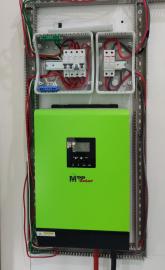chrisski
Solar Boondocker
- Joined
- Aug 14, 2020
- Messages
- 5,326
What do you use for backing for your inverter?
My installation manual said non-flammable backing. A quick search gave me a definition of flammable, but nothing to use.
Which for me lead to a bit of research to see if plywood was acceptable. All the DIY pictures I saw used plywood, a few were painted. That lead to look at different types of paint, but nothing really about fireproof paints, and a little about water based paints. Someone a while ago suggested truck bed liner like herculiner, but I don't know if that is flammable or not. For non-flammable backings, I could not really find anything on google, and a bit of a search lead me to see that a 3' X 5' long and 1/4" thick cement board could be purchased at home depot, and is non-combustible, which is even better then non-flammable. Unfortunately, this product is hardened like cement, as the name cement board implies, and did not look easy to work with with the safety knife and Dremel I had available for tools.
I used a 3/4" plywood board mounted vertically, cut a piece of thing gauge aluminum, 24 gauge I think, slightly bigger than each device and screwed that to the plywood and then mounted it. Where the wires would connect and disconnect from the system, I cut that back so wires could not short together on this aluminum sheet. I mounted the Charge controller 100 volt 50 amp and inverter with the aluminum backing. The midnight Solar combiner box, I simply took 4 screws and mounted that to the plywood.
I'm sure there's something easy I missed.
My installation manual said non-flammable backing. A quick search gave me a definition of flammable, but nothing to use.
Which for me lead to a bit of research to see if plywood was acceptable. All the DIY pictures I saw used plywood, a few were painted. That lead to look at different types of paint, but nothing really about fireproof paints, and a little about water based paints. Someone a while ago suggested truck bed liner like herculiner, but I don't know if that is flammable or not. For non-flammable backings, I could not really find anything on google, and a bit of a search lead me to see that a 3' X 5' long and 1/4" thick cement board could be purchased at home depot, and is non-combustible, which is even better then non-flammable. Unfortunately, this product is hardened like cement, as the name cement board implies, and did not look easy to work with with the safety knife and Dremel I had available for tools.
I used a 3/4" plywood board mounted vertically, cut a piece of thing gauge aluminum, 24 gauge I think, slightly bigger than each device and screwed that to the plywood and then mounted it. Where the wires would connect and disconnect from the system, I cut that back so wires could not short together on this aluminum sheet. I mounted the Charge controller 100 volt 50 amp and inverter with the aluminum backing. The midnight Solar combiner box, I simply took 4 screws and mounted that to the plywood.
I'm sure there's something easy I missed.






